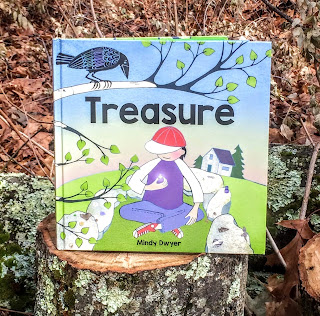 Treasure
TreasureBy Mindy Dwyer
Published April 2019
Mom's Review
Finding treasures. Having a secret, special place. Delighting in the natural world. These universal childhood experiences resonated with T and each family member who read him Treasure. The premise is that a boy collects treasures, a crow watches him and steals a treasure, and they collect and share the treasures in the end. Because there is only a single word per page (treasure, storm, scatter, etc.), each reader is free to let his/her imagination take flight. T stuck strictly to the illustrations when creating his narrative while I added a bit of back story and changed up my interpretation each time. Treasure is also the perfect book for us to read in T's secret spot in the woods, which is a circle of tree trunk pieces with treasures on a few of them...sound anything like that cover you're looking at? Although T said in the interview below that his spot is nothing like the boy's, he had earlier said that this boy's place is just like his.
Treasure is a bit of an anomaly for me. I am not usually a big fan of children's books that have only one word per page because I often find them basic to the point of uselessness (I question the value of showing a baby the printed word "smile" alongside a smile; s/he recognizes a smile in real life). Treasure is decidedly NOT this type of book. Rather than merely a "learn-this-word" book, it is a framework for creativity. Based on the illustrations and the guide words, the audience can construct a unique narrative. Additionally, emerging readers can indeed use this to practice words like "discover," "collect," and "accept."
Treasure is a delight to read and reread and reread again.
Son's Review
(Age: almost 5)
Mom: Do you imagine the same story every time?
Son: Yes. So there's a boy and there's a bin of treasures in a spot in the forest behind his house. And there's a storm; then there was stuff that was scattered. And there was collecting and sharing.
Mom: How is the boy like you?
Son: No. He's not any like me.
Mom: But you also have a secret spot in the woods.
Son: Yes, but it's not like his spot one single bit because it's a clubhouse and his is a treasure spot that they made of a circle of rocks.
Mom: What is your favorite part?
Son: There is no favorite part because it's just a word book for learning words and imagining in your mind.
Mom: What do you think of having only a single word on each page?
Son: I like that.
Mom: Tell me what you thought of the crow...Would you want to befriend a wild crow?
Son: The crow is kind of naughty because he took the boy's favorite button on purpose...Yes, just because. I would want to be friends with all the wild animals.
Mom: What is the most important thing to know about Treasure?
Son: Well, that it's a one word book.
Why we chose this book:
We loved How Raven Got His Crooked Nose (we featured it in the Spotlight on Traditional Literature post), which is also illustrated by Mindy Dwyer. When the opportunity arose to review another work by this artist, we were delighted! A review copy was provided in exchange for an honest review.
Extra:
Check out Mindy Dwyer's website here. Many of her books are concerned with Alaska and the Pacific Northwest.
Comments
Post a Comment